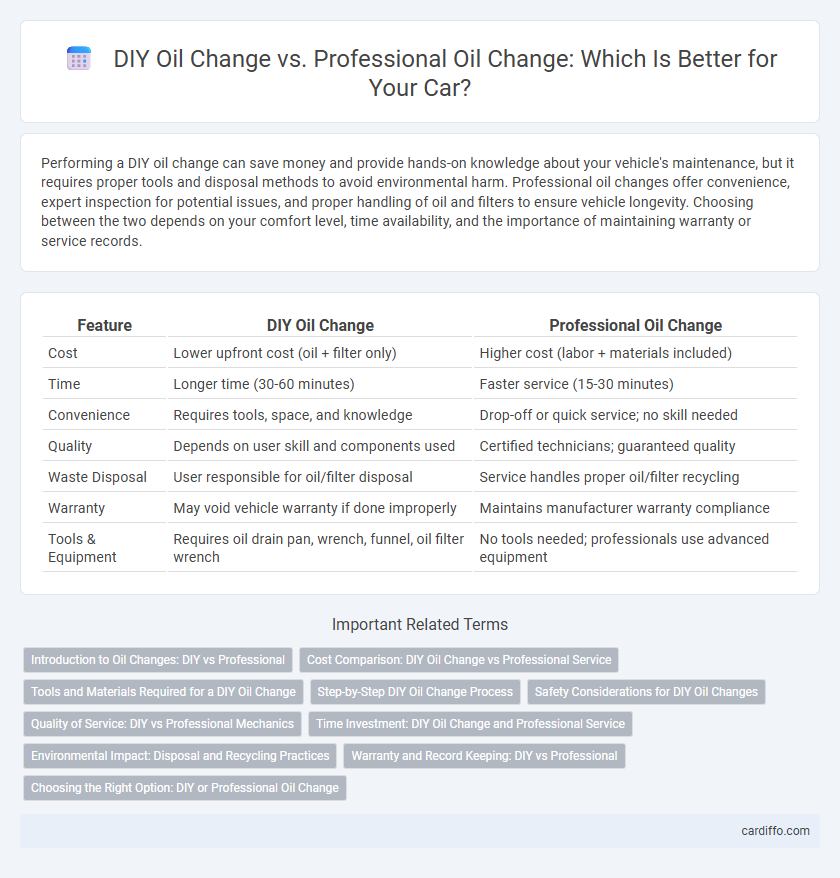Performing a DIY oil change can save money and provide hands-on knowledge about your vehicle's maintenance, but it requires proper tools and disposal methods to avoid environmental harm. Professional oil changes offer convenience, expert inspection for potential issues, and proper handling of oil and filters to ensure vehicle longevity. Choosing between the two depends on your comfort level, time availability, and the importance of maintaining warranty or service records.
Table of Comparison
| Feature | DIY Oil Change | Professional Oil Change |
|---|---|---|
| Cost | Lower upfront cost (oil + filter only) | Higher cost (labor + materials included) |
| Time | Longer time (30-60 minutes) | Faster service (15-30 minutes) |
| Convenience | Requires tools, space, and knowledge | Drop-off or quick service; no skill needed |
| Quality | Depends on user skill and components used | Certified technicians; guaranteed quality |
| Waste Disposal | User responsible for oil/filter disposal | Service handles proper oil/filter recycling |
| Warranty | May void vehicle warranty if done improperly | Maintains manufacturer warranty compliance |
| Tools & Equipment | Requires oil drain pan, wrench, funnel, oil filter wrench | No tools needed; professionals use advanced equipment |
Introduction to Oil Changes: DIY vs Professional
Performing an oil change is essential for maintaining engine health and prolonging vehicle lifespan. DIY oil changes offer cost savings and convenience but require proper tools, knowledge, and disposal methods. Professional oil changes ensure expert handling, use of high-quality oils, and comprehensive vehicle inspections for optimal performance.
Cost Comparison: DIY Oil Change vs Professional Service
Performing a DIY oil change typically costs between $20 to $40 for oil and filter supplies, saving labor fees associated with professional services that range from $50 to $100 or more. While DIY oil changes reduce expenses by eliminating mechanic charges, professional services often include perks like proper oil disposal and inspection of other vehicle components. Evaluating these cost differences helps vehicle owners decide based on budget constraints and the value of expert service.
Tools and Materials Required for a DIY Oil Change
Performing a DIY oil change requires essential tools such as an oil filter wrench, a drain pan, a socket set, and a funnel, along with high-quality motor oil and an appropriate oil filter. Access to a jack or ramps is often necessary to safely lift the vehicle, and disposable gloves and rags help manage spills and maintain cleanliness. Using the correct oil grade and filter type specified by the vehicle manufacturer is critical to ensure engine performance and longevity.
Step-by-Step DIY Oil Change Process
Changing your oil yourself involves several key steps: first, warm up the engine to ensure the oil flows out smoothly, then lift the vehicle securely with jack stands or ramps. Next, drain the old oil by removing the drain plug and letting it empty completely, followed by replacing the oil filter with a new one to maintain engine performance. Finally, refill with the specified type and amount of oil, check for leaks, and reset the oil change indicator if your car has one.
Safety Considerations for DIY Oil Changes
DIY oil changes carry safety risks such as exposure to hot engine parts and hazardous oil, increasing the chance of burns or skin irritation without proper protective gear. Improper disposal of used oil can harm the environment and violate regulations, requiring knowledge of local disposal facilities. Professional oil changes ensure safe handling, recycling of oil, and adherence to safety protocols, reducing the risk of injury and environmental damage.
Quality of Service: DIY vs Professional Mechanics
DIY oil changes offer cost savings and convenience but often lack the precision and thoroughness of professional services, which use high-quality tools and ensure proper disposal of used oil. Professional mechanics perform comprehensive inspections during oil changes, identifying potential engine issues early and maintaining optimal vehicle performance. The superior quality of service from experts reduces the risk of damage and extends engine lifespan compared to typical DIY attempts.
Time Investment: DIY Oil Change and Professional Service
DIY oil changes typically require about 30 to 45 minutes, including preparation and cleanup, making them time-efficient for those with basic mechanical skills. Professional oil changes usually take 15 to 30 minutes, benefiting from specialized tools and experienced technicians to ensure faster service. Time investment considerations depend on convenience, expertise, and the availability of professional service centers.
Environmental Impact: Disposal and Recycling Practices
DIY oil changes often result in improper disposal of used motor oil, posing significant environmental hazards due to contamination of soil and water sources. Professional oil change services follow strict regulations for oil collection, storage, and recycling, ensuring environmentally responsible disposal. Utilizing certified recycling programs, professionals help reduce the risk of pollution and promote sustainable automotive maintenance practices.
Warranty and Record Keeping: DIY vs Professional
Performing a DIY oil change may risk voiding your vehicle's warranty if proper procedures or approved products are not used, while professional oil changes ensure compliance with manufacturer standards. Certified service centers maintain detailed maintenance records vital for warranty claims and resale value. Keeping documented proof of professional oil changes supports warranty validity and helps track vehicle health over time.
Choosing the Right Option: DIY or Professional Oil Change
Choosing the right option between a DIY oil change and a professional service depends on factors such as your mechanical skill level, available tools, and time. DIY oil changes offer cost savings and convenience for those familiar with vehicle maintenance, while professional oil changes ensure proper disposal, thorough inspection, and use of high-quality lubricants. Evaluating your comfort with the process and prioritizing vehicle longevity will guide you in selecting the most suitable oil change method.
DIY Oil Change vs Professional Oil Change Infographic

 cardiffo.com
cardiffo.com